Fiske Cornet in Bb with Double Piston Valves
When I first saw this instrument, I called it a post horn, thinking myself quite knowledgeable on the subject. I had learned a few years back that the very small bore trumpets with double piston valves were called that in the US in the 1840s. Nobody that I knew had ever seen an instrument made by Isaac Fiske that was anything like this before, although an 1843 newspaper account, reported by Dr. Robert Eliason, states that Fiske was selling post horns. The only other instrument with double piston valves by this maker previously known was decidedly Saxhorn in form. Examples of the post horns previously known were made by Graves & Co., E.G. Wright, Allen Mfg. Co. and S.W. Richardson along with some that were imported at the time.
I had some email correspondences on this subject and, as luck would have it, Sabine Klaus asked me to read over and comment on some of the text to be included in her volume on the early history of trumpets and other high brass with valves. (Sabine's two previous volumes covering the high brass of the pre-valve era are the absolute best source of information on the subject.) Sabine had done much research on the brass instrument makers in Cincinnati, including Franz G. Kaiser, an example of an alto horn of his being in the Utley collection of the National Music Museum. This alto has the same mechanism driving double piston valves as seen in this Fiske cornet and Sabine reminded me that this is called "Neumainzer" and stated that her research indicated that this mechanism had been introduced to the US in the early 1850s.
This has side action levers with long leaf springs, distinguishing it from the earlier "Mainzer" design, which is the mechanism seen in the post horns mentioned above. I'm sure that you've already come to the conclusion that these mechanisms along with the names originated in Germany, as did Kaiser and the other Cincinnati makers. The Anglo-American makers must have adopted this technology from German workers they employed, by copying existing instruments or by importing the mechanisms for use in their production.
The third photo above from Mark Elrod’s collection, from the1860s of William S. Pearson in Manchester New Hampshire, holding a very similar cornet. This would have already been an old-fashioned instrument by then, but it appears to have been well cared for. The only detectable differences are the bracing of the valve lever carriage, lyre mount, absence of mouthpipe shank and the lack of cover over the valves. Since Fiske's version of this design was a close copy of what was being made in Germany, there is no way of knowing for sure that this one was also made by him, but the resemblance is remarkable.
Another Bb cornet that utilizes the same valve mechanism was made by E.G. Wright during this same time period. For both of these makers, these cornets with larger bores, were making their move from the era of keyed bugles and post horns to that of cornets and Saxhorns. This is what distinguishes these cornets of the 1850s from the post horns of the 1840s; the adoption of the Neumainzer mechanism being coincident, but not dependent on it.
The valve bore of the Fiske measures .430" and the Wright about .425”. The valve bores of the American post horns range from .330" to .367". While the bell taper and flare profiles changed by a much smaller degree, the later cornets were becoming larger in this area as well. Other examples of American cornets from the 1850s, featured on this site include those by B.F. Richardson, Graves & Co. and Teltow.
This is an extremely narrow slice of the history of brass instruments and music in the US, but I find it exciting to find these previously "missing links" between the earliest use of brass instruments in America and the brass band boom that followed immediately afterwards. Along with keyed bugles, the post horns must have balanced well with woodwinds, small bore trombones and even the lower Saxhorns in small numbers. When the brass bands became larger in size and volume, the post horns would have been rendered obsolete and larger bore cornets a better option. That trend must have continued for the next two decades, judging by the increase in cornet bore sizes into the 1860s and peaking in the late 1870s when Boston's cornets had valve bores measuring .487".
During the 1840s, US makers also used double piston valves with Mainzer mechanisms in larger instruments and came up with the unique name: trombacellos. These were made in Eb alto, Bb tenor and F bass, matching the standard trombone pitches. There is no evidence that any of these sizes were made with larger bores and neu-Mainzer mechanisms as there were in Europe. American makers were catching up to their European leaders and started making larger alto, tenor, bass and contrabass Saxhorns with rotary valves in the early 1850s.
The last photo is a post horn made by Isaac Fiske in about 1843. This instrument was found five years later by Barry Norden in Cedar Rapids, Iowa and shows what Fiske was making at the time of the 1843 newspaper article mentioned above. This instrument now has its own page describing it in detail.
Post horn in Bb by Isaac Fiske.





